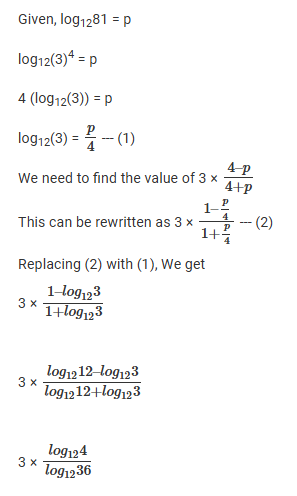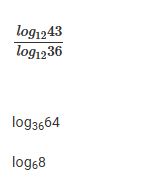Live Updates
• CATKing has launched new chat bot.

• New video on Logs has been released.
495
Learners
asked the doubt

Previous Year Questions
Ramesh and Ganesh can together complete a work in 16 days. After seven days of working together, Ramesh got sick and his efficiency fell by 30%. As a result, they completed the work in 17 days instead of 16 days. If Ganesh had worked alone after Ramesh got sick, in how many days would he have completed the remaining work?
Video Explanation

Explanatory Answer

Given that Ramesh and Ganesh can together complete a work in 16 days
After seven days of working together, Ramesh got sick and his efficiency fell by 30%.
To the original schedule of 16 days there are 9 more days and in this 9 days Ramesh fall short by 9
× 0.3x = 2.7x where x is the work done by Ramesh in a day
So the change = 2.7x (i.e. the gap because of drop in efficiency)
This 2.7x is compensated by one day of Ganesh + another 0.7 of Ramesh
2.7x = G + 0.7 x (Because the last day also he works with reduced efficiency)
2x = G
Hence Ganesh works twice as that of Ramesh.
If Ganesh had worked alone after Ramesh got sick means in the 7 days Ramesh would have
completed 7/48 of the task
Ganesh on each day can do 1/24 of the task
Task to be completed by Ganesh is 41/48 completely
One day he can complete 1/24 so 41/48 × 24/1 = 20.5 days
If Ganesh had worked alone after Ramesh got sick, the no.of days needed for completing the
remaining work is 20.5 – 7 = 13.5 days
A tank is emptied everyday at a fixed time point. Immediately thereafter, either pump A or pump B or both start working until the tank is full. On Monday, A alone completed filling the tank at 8 pm. On Tuesday, B alone completed filling the tank at 6 pm. On Wednesday, A alone worked till 5 pm, and then B worked alone from 5 pm to 7 pm, to fill the tank. At what time was the tank filled on Thursday if both pumps were used simultaneously all along?
Video Explanation

Explanatory Answer
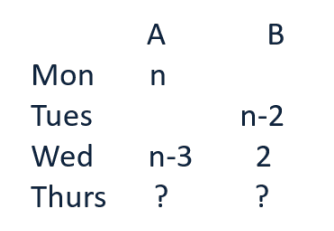
Given that a tank is emptied everyday at a fixed time point and after that either pump A or B or
both start working to fill the tank.
On Monday, A alone completed filling the tank at 8 pm.
On Tuesday, B alone completed filling the tank at 6 pm.
On Wednesday, A alone worked till 5 pm, and then B worked alone from 5 pm to 7 pm, to fill the
tank.
We have to find at what time will the tank filled on thursday if both were used simultaneously all
along
A is doing 3 hours less work on Wednesday which B completes in 2 hours therefore B = 1.5 A
⟹ (n)/(n-2) = 3/2
⟹ 2n = 3n – 6
⟹ n = 6
A takes 6 hours and B takes 4 hours or the tank is closed at 2 pm
When they are together open
⟹ 1/6 + 1/4 = (2+3)/12
⟹ Rate is 5/12 or they can fill the entire tank in 12/5 hours which is 2 hours 24 minutes
Starting from 2 pm, they fill the entire tank by 4:24 pm
Here the break through is figuring out the ratio or efficiency of the rate at which they fill is B : A
= 3 : 2
The conventional way is
⟹ (n−3)/n + 2/(n-2) = 1
n-3 hours at the rate of 1/𝑛 per hour
2 hours at the rate 1/(𝑛−2) per hour
Solving this we get n = 6 and we can find solution using this n.
Points A and B are 150 km apart. Cars 1 and 2 travel from A to B, but car 2 starts from A when car 1 is already 20 km away from A. Each car travels at a speed of 100 kmph for the first 50 km, at 50 kmph for the next 50 km, and at 25 kmph for the last 50 km. The distance, in km, between car 2 and B when car 1 reaches B is
Video Explanation

Explanatory Answer
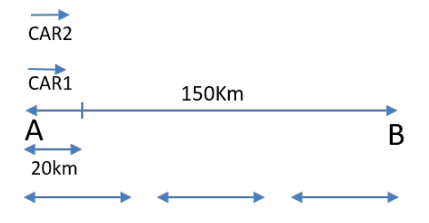
Given that points A and B are 150 km apart.
Cars 1 and 2 travel from A to B, but car 2 starts from A when car 1 is already 20 km away from A.
Each car travels at a speed of 100 kmph for the first 50 km, at 50 kmph for the next 50 km, and at
25 kmph for the last 50 km.
The Car 1 is 20km away from A and it travels at 100kmph and the time taken is 20/100 = 1/5hr
So car 2 is 12 minutes behind car 1.
We have to find the distance in km, between car 2 and B when car 1 reaches B.
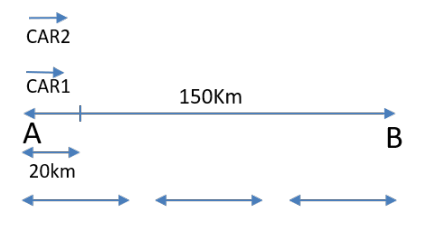
If car 1 reaches B, car 2 will take 12 minutes to reach b.
Distance between car 2 and B is 25 × 1/5 = 5 kms
The distance, in km, between car 2 and B when car 1 reaches B is 5 kms
A jar contains a mixture of 175 ml water and 700 ml alcohol. Gopal takes out 10% of the mixture and substitutes it by water of the same amount. The process is repeated once again. The percentage of water in the mixture is now
Video Explanation

Explanatory Answer
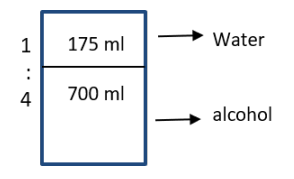
Given that a jar contains a mixture of 175 ml water and 700 ml alcohol.
It is given that 10% of the mixture is removed and it is substituted by water of the same amount
and the process is repeated once again
Now we have to find the percentage of water in the mixture.
Since the mixture is removed and substituted with water, we can deal with alcohol and the second
step we can find how much amount of alcohol is retained and not about how much amount of
alcohol is removed
As 10% of alcohol is removed, 90% of alcohol is retained
So alcohol remaining = 700 × 90% × 90%
⟹ 700 × 0.9 × 0.9 = 567
We totally have 875 ml overall mixture and of this 567 ml is alcohol.
Remaining 875 – 567 = 308 is the amount of water.
We have to find the percentage of water in the mixture i.e. 308/875
Approximately 308 is 30% of 1000 so by this we know that 308 is more than 30%
Hence 35.2% is the percentage of water in the given mixture.
If the sum of squares of two numbers is 97, then which one of the following cannot be their product?
Video Explanation

Explanatory Answer
Given that the sum of squares of two numbers is 97 i.e. a 2 + b 2 = 97
From the given options we have to find which one cannot be their product i.e. ab
A. 64 ⟹ 2ab = 128
B. −32 ⟹ 2ab = -64
C. 16 ⟹ 2ab = 32
D. 48 ⟹ 2ab = 96
2ab is found because we know that
a 2 + b 2 + 2ab ≥ 0
a 2 + b 2 - 2ab ≥ 0
By this we can know that 97 + 128 works but 97 - 128 doesn’t works so we can understand option
A cannot be the product and the rest can be.
a 2 + b 2 ≥ |2ab|
a 2 + b 2 ≥ 2ab
a 2 + b 2 ≥ -2ab
⟹( a 2 + b 2 ) / 2 ≥ |ab|
So here 2ab should lie between +97 and -97 or ab should be less than 97/2 or greater than −97/2,
so except option A all the other options works so option A 64 cannot be the product
On a long stretch of east-west road, A and B are two points such that B is 350 km west of A. One car starts from A and another from B at the same time. If they move towards each other, then they meet after 1 hour. If they both move towards east, then they meet in 7 hrs. The difference between their speeds, in km per hour, is
Video Explanation

Explanatory Answer
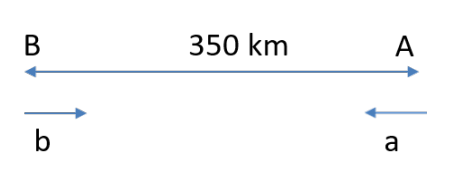
Given that A and B are two points such that B is 350 km west of A. One car starts from A and
another from B at the same time.
They meet after one hour or their relative velocity is (a + b)km/hr and their relative distance is
350kms
a + b = 350 which is equal to 350 kms/hr
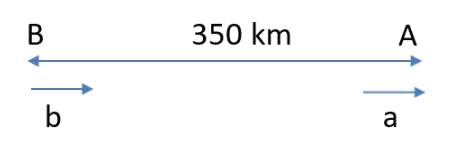
If they both move towards east, then they meet in 7 hrs.
We have to find the difference between their speeds, in km per hour. B is catching upon A, so once
again their relative distance will be 350kms.
Relative speed = b – a , B travels faster so that it can meet a.
⟹ 350/ 𝑏−𝑎 = 7
⟹ b - a = 50 km/hr
We know that b + a = 350 km/hr
By this we can find the values of a and b but they have asked for only the difference between their
speeds which is b – a = 50km/hr
The value of the sum 7 x 11 + 11 x 15 + 15 x 19 + . + 95 x 99 is
Video Explanation

Explanatory Answer
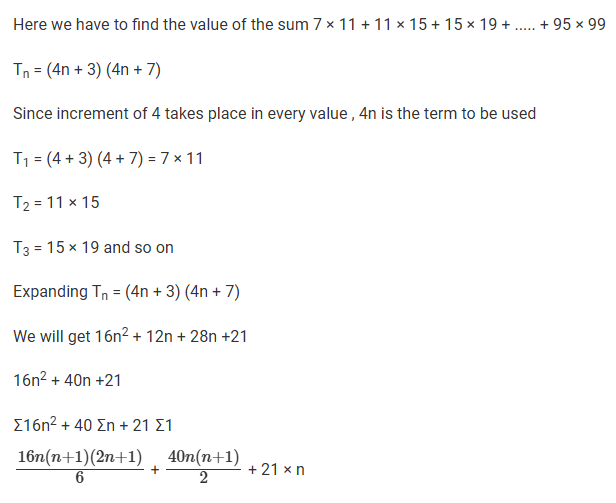
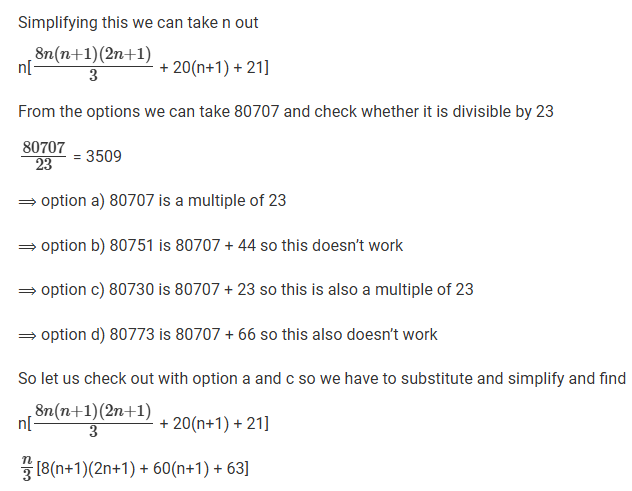
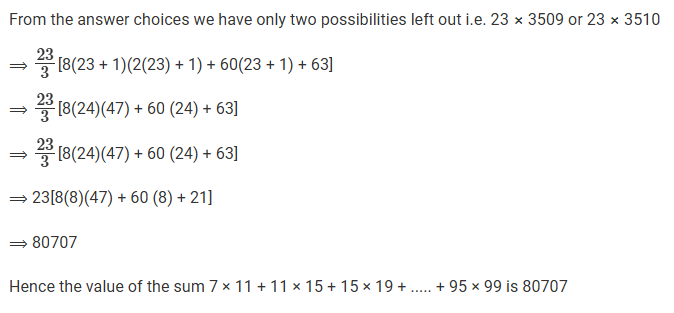
A parallelogram ABCD has area 48 sqcm. If the length of CD is 8 cm and that of AD is s cm, then which one of the following is necessarily true?
Video Explanation

Explanatory Answer
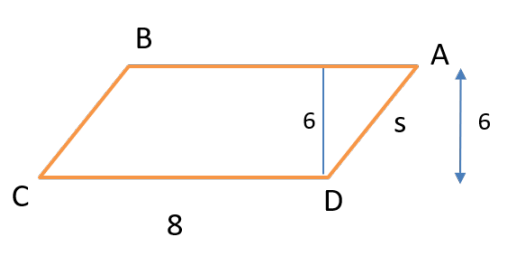
Given that a parallelogram ABCD has an area 48 sq cm. The length of CD is 8 cm and that of AD is s cm
Since the area given here is 48 sq.cm the height can be found as 6 sq.cm
We have to find which of the following options is necessarily true

Since this (shaded portion) is a right angled triangle with 6 as its height and s as its hypotenuse so we can assure that s ≥ 6 and s cannot be less than 6 so we can eliminate the other options.
By this we can come to the conclusion that s ≥ 6
The smallest integer n such that n3 - 11n2 + 32n - 28 > 0 is
Video Explanation

Explanatory Answer



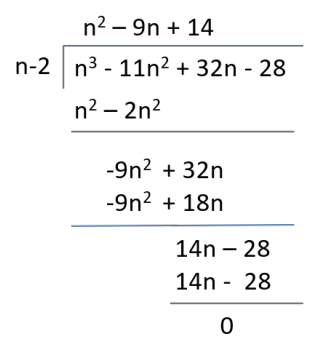

The smallest integer n for which 4n > 1719 holds, is closest to
Video Explanation

Explanatory Answer

The area of a rectangle and the square of its perimeter are in the ratio 1 : 25. Then the lengths of the shorter and longer sides of the rectangle are in the ratio
Video Explanation

Explanatory Answer
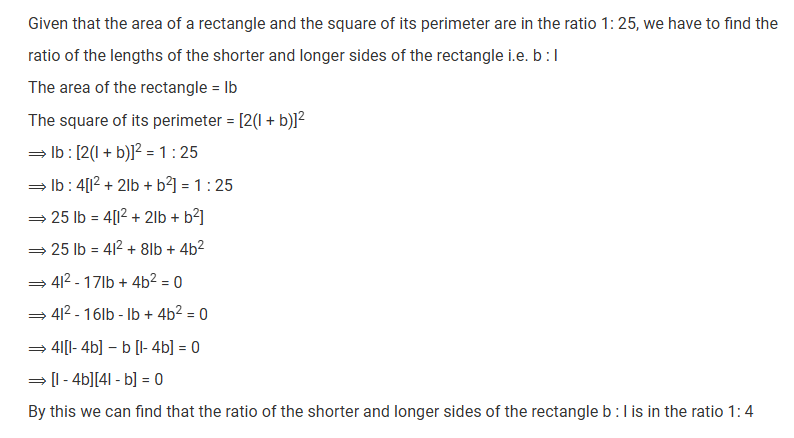
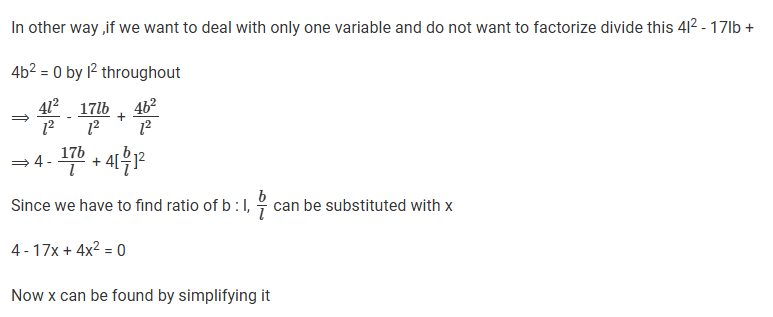
A 20% ethanol solution is mixed with another ethanol solution, say, S of unknown concentration in the proportion 1:3 by volume. This mixture is then mixed with an equal volume of 20% ethanol solution. If the resultant mixture is a 31.25% ethanol solution, then the unknown concentration of S is
Video Explanation

Explanatory Answer
Given that 20% ethanol solution is mixed with another ethanol solution, say, S of unknown concentration in the proportion 1:3 by volume

This M is then mixed with an equal volume of 20% ethanol solution. If the resultant mixture is a 31.25% ethanol solution ,then the unknown concentration of S has to be found

Equal quantities of mixture and 20% ethanol solution are mixed in equal ratio to get 31.25%
The mixture and 20% ethanol solution are mixed in equal ratio to get 31.25%. This 31.25% is 11.25% more than this 20%. This mixture must be 11.25% more than 31.25% so mixture is equal to 42.5%

This mixture 42.5% is mixed in the ratio 1:3

Using allegations we can find this 22.5% which should be in the ratio 1:3 so the other one is 7.5%
S = 42.5 + 7.5
S = 50%
Here to find the solution, do the second thing first and then go to the first thing
The second one is mixed in the ratio 1 : 1 so that the final thing should be bang in the middle
In a tournament, there are 43 junior level and 51 senior level participants. Each pair of juniors play one match. Each pair of seniors play one match. There is no junior versus senior match. The number of girl versus girl matches in junior level is 153, while the number of boy versus boy matches in senior level is 276. The number of matches a boy plays against a girl is
Video Explanation

Explanatory Answer
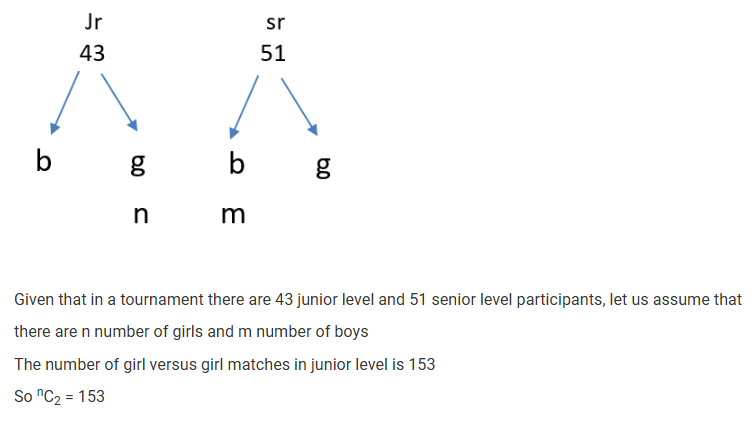
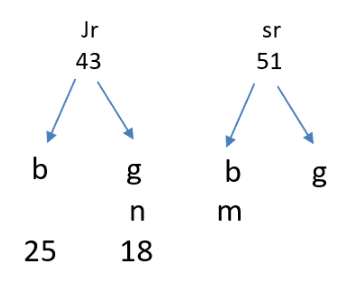
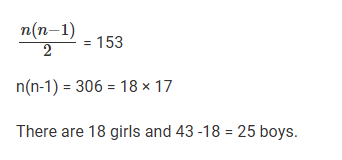
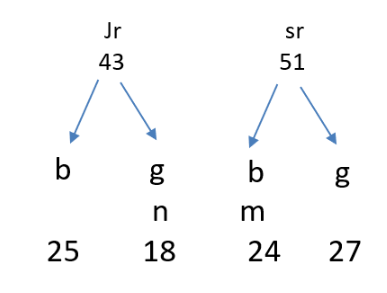

If p3 = q4 = r5 = s6, then the value of logs (pqr) is equal to
Video Explanation

Explanatory Answer
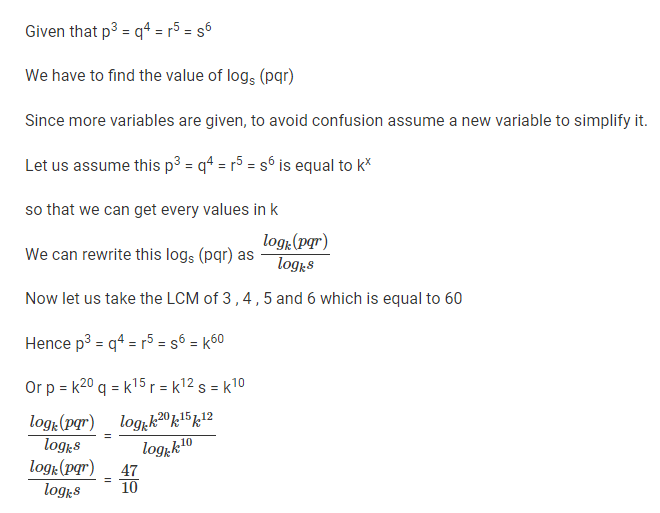
A chord of length 5 cm subtends an angle of 60° at the centre of a circle. The length, in cm, of a chord that subtends an angle of 120° at the centre of the same circle is
Video Explanation

Explanatory Answer
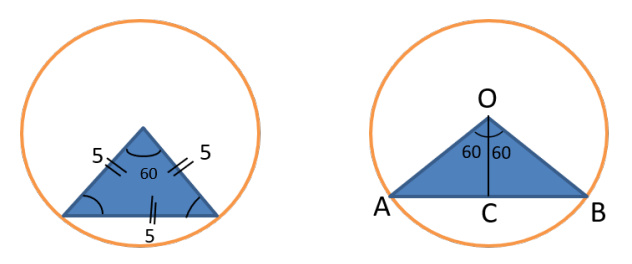
Given that a chord of length 5 cm subtends an angle of 60° at the centre of a circle.
We have to find the length of a chord that subtends an angle of 120° at the centre of the same
circle
sin 60° = BC/OB
⟹ √3/2 = BC/5
⟹ BC = 5√3/2 and AC = 5√3/2
So AB = 5√3/2 + 5√3/2= 5√3
The length of a chord that subtends an angle of 120° at the centre of the same circle is 5√3
If N and x are positive integers such that NN = 2160 and N2 + 2N is an integral multiple of 2x, then the largest possible x is
Video Explanation

Explanatory Answer


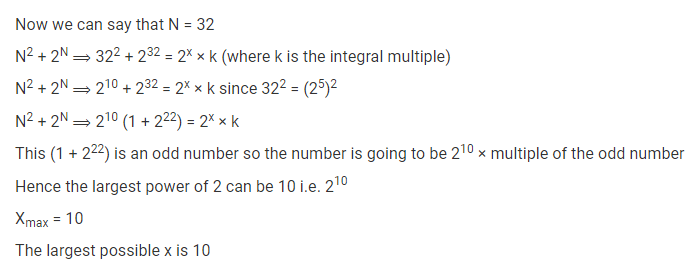
From a rectangle ABCD of area 768 sq cm, a semicircular part with diameter AB and area 72π sq cm is removed. The perimeter of the leftover portion, in cm, is
Video Explanation

Explanatory Answer

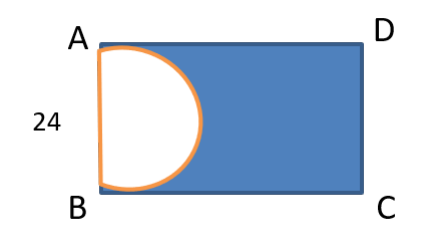
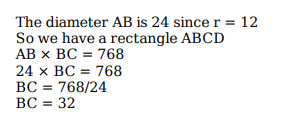

Let t1, t2,… be real numbers such that t1+ t2 +. + tn = 2n2 + 9n + 13, for every positive integer n ≥ 2. If tk=103, then k equals
Video Explanation

Explanatory Answer
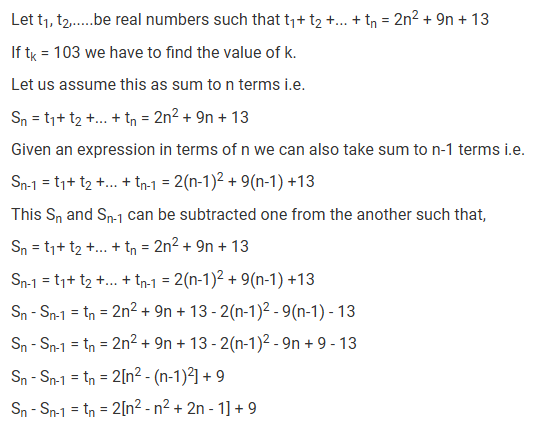
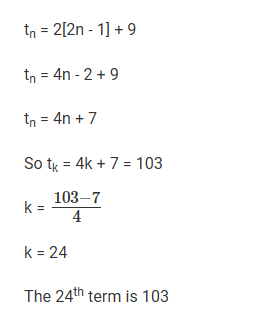
On a triangle ABC, a circle with diameter BC is drawn, intersecting AB and AC at points P and Q, respectively. If the lengths of AB, AC, and CP are 30 cm, 25 cm, and 20 cm respectively, then the length of BQ, in cm, is
Video Explanation

Explanatory Answer
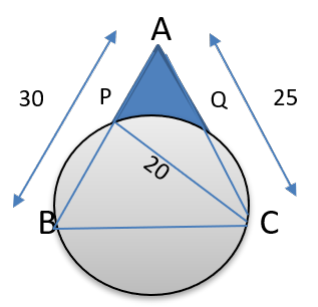

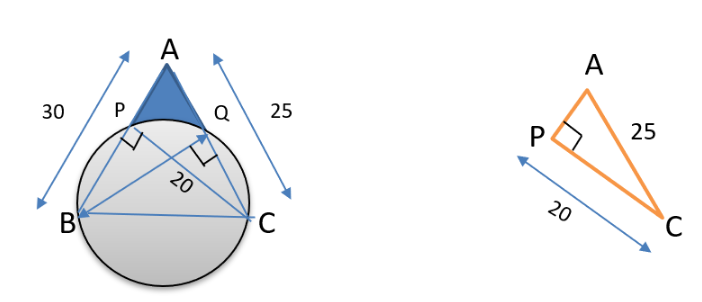
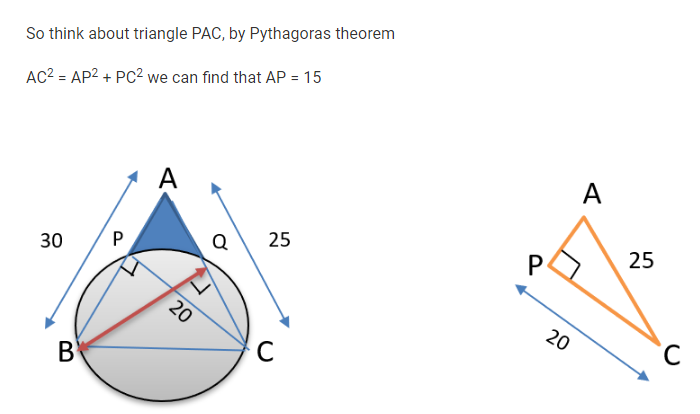
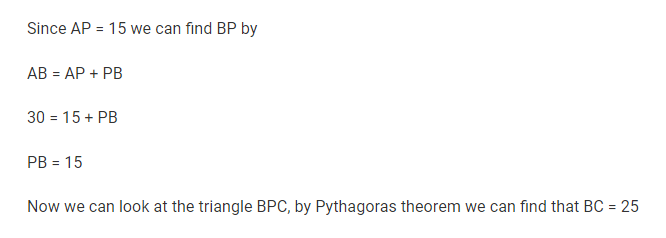
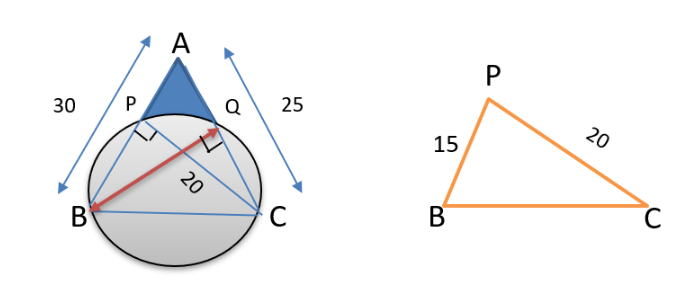
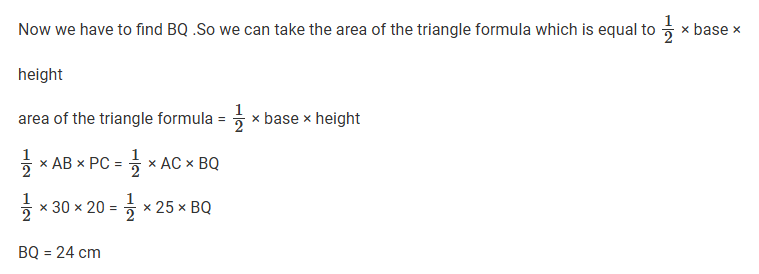
There are two drums, each containing a mixture of paints A and B. In drum 1, A and B are in the ratio 18 : 7. The mixtures from drums 1 and 2 are mixed in the ratio 3 : 4 and in this final mixture, A and B are in the ratio 13 : 7. In drum 2, then A and B were in the ratio
Video Explanation

Explanatory Answer

Given that two drums each containing a mixture of paints A and B. In drum 1, A and B are in the
ratio 18 : 7. Drums 1 and 2 are mixed in the ratio 3 : 4 and in the final mixture A and B are in the
ratio 13 : 7. For these kinds of questions do not consider separately as A and B. Deal with either A
or B as a share of overall
Here A is 18/25 of overall
In D2, let us assume the proportion of A with respect to the overall mixture is x. 3 parts of D1 is
mixed with parts of D2 to give proportion of A of which is (13/20) th of the overall mixture. From
here on, it is weighted averages.
So, {(18/5)×3 + (x×4)} / 7 = 13/20
54/25 + 4𝑥 = 91/20
4𝑥 = 91/20 - 54/25
4𝑥 = (455−216)/100 = 239/100
𝑥 = 239/400
In drum 2, A is 239/400 so B should be the remaining. Therefore, A : B = 239 : 161
Let a1, a2, . , a52 be positive integers such that a1 < a2 < . < a52. Suppose, their arithmetic mean is one less than the arithmetic mean of a2, a3, ., a52. If a52 = 100, then the largest possible value of a1 is
Video Explanation

Explanatory Answer

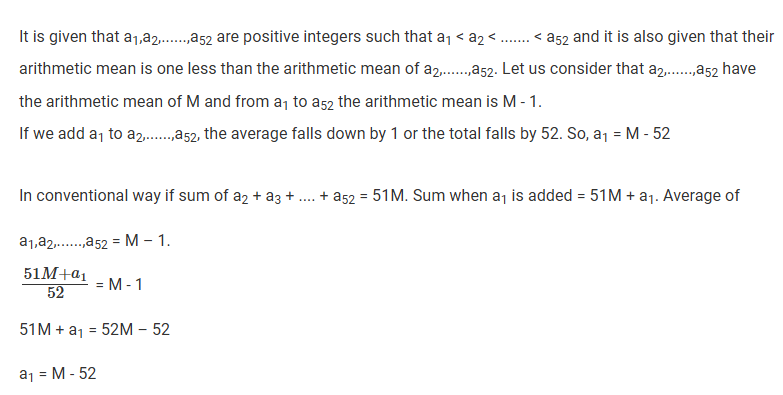
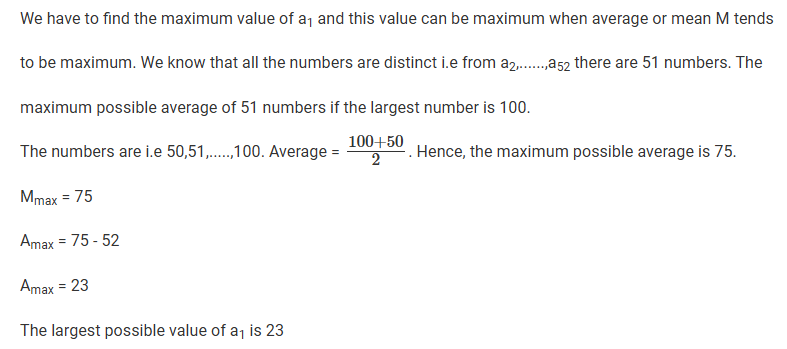
Points A, P, Q and B lie on the same line such that P, Q and B are, respectively, 100 km, 200 km and 300 km away from A. Cars 1 and 2 leave A at the same time and move towards B. Simultaneously, car 3 leaves B and moves towards A. Car 3 meets Car 1 at Q, and Car 2 at P. If each car is moving in uniform speed then the ratio of the speed of Car 2 to that of Car 1 is
Video Explanation

Explanatory Answer

It is given that points A, P, Q and B lie on the same line such that P, Q and B are 100 km, 200 km and 300 km away from A. Let us draw the diagram first. All of them are on the same straight line and P, Q lie between A and B.
Cars 1 and Cars 2 leave A at the same time and move towards B. Simultaneously, Car 3 leaves B and moves towards A. Let us add more details to the diagram. C1 and C2 move towards B and C3 moves towards A. C3 meets C1 at Q and C3 meets C2 at P.

Let us assume the speeds of Car 1, 2, and 3 to be C1, C2 and C3 respectively. Car 1 is travelling quicker than Car 2. When Car 1 travels 200 km to reach Q, Car 3 has travelled 100 km or ratio of their speeds, C1 : C3 is 2 : 1.C1 and C2 move towards B and C3 moves towards A. C3 meets C1 at Q and C3 meets C2 at P.
Let us assume the speeds of Car 1, 2, and 3 to be C1, C2 and C3 respectively.When Car 3 travels 200 km to reach P, Car 2 has travelled 100 km or ratio of their speeds, C3 : C2 is 2 : 1. Now we have all the ratios. We know that C1 : C3 is 2 : 1 and C3 : C2 is 2 : 1. We can see that C3 is the common link
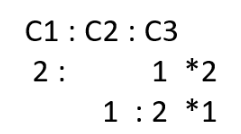
So, taking LCM of C3, we get,

We can see that ratio of speeds of Car 2 to Car 1 is 1 : 4. Hence, C2 : C1 = 1 : 4
In an apartment complex, the number of people aged 51 years and above is 30 and there are at most 39 people whose ages are below 51 years. The average age of all the people in the apartment complex is 38 years. What is the largest possible average age, in years, of the people whose ages are below 51 years?
Video Explanation

Explanatory Answer
Given that the Average age of all the residents in the complex = 38 years
Number of people having ages 51 and above = 30
Number of people having ages below 51 ≤ 39
Since we need to maximize the average age of people below 51 and to maintain the combined average as 38 years, we need to consider the ages of people above 51 as 51 (Any more than that would lower the other value)
Also, We need to take the Number of people having ages below as 39 (Again, for maximizing the value)

So, 13 : 38-x = 39 : 30 = 13 : 10
38 - x = 10
x = 28
Average age of people whose ages are below 51 = 28 years
Let f(x)=min{2x2, 52 - 5x}, where x is any positive real number.Then the maximum possible value of f(x) is
Video Explanation

Explanatory Answer
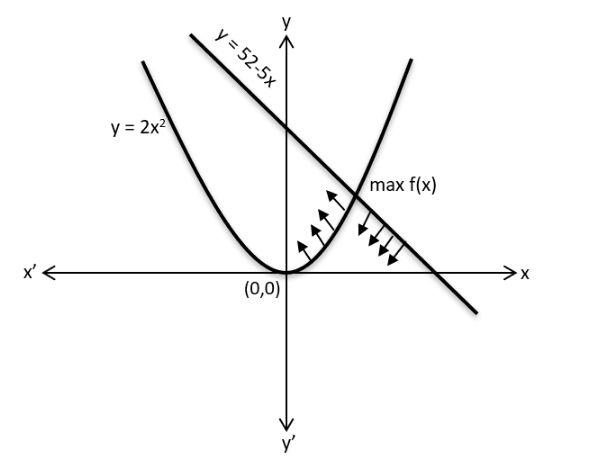
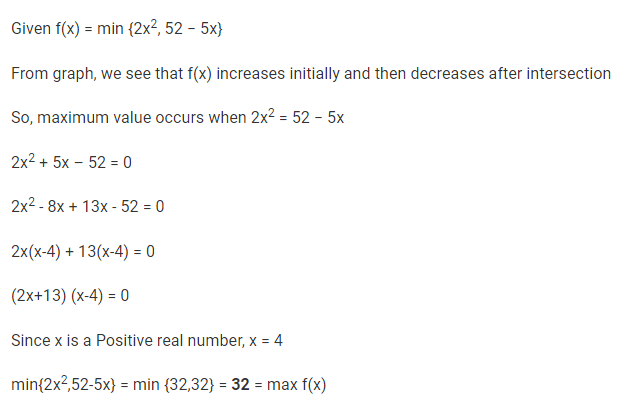
If among 200 students, 105 like pizza and 134 like burger, then the number of students who like only burger can possibly be
Video Explanation

Explanatory Answer
Given that out of 200 students, 105 like Pizza and 134 like Burger
In order to find the possible number of students who like only Burger, we need to find the range between the minimum and maximum possible number of students
Minimum possible number of Students who like only Burger:

For this, we must try to optimize the Venn diagram in such a way that it has maximum intersection
No of Students who like only Burger = 134 – 105= 29
Maximum possible number of Students who like only Burger:

For this, we must optimize the Venn diagram in such a way that it has minimum intersection
We know that total number of Students = 200
So, Minimum number of students who like both = 105 + 134 – 200 = 39 students
Students who like Burger = 134
Max. no of Students who like only Burger = 134 – 39 = 95
So range => 29 ≤ n ≤ 95
From the options, only (D) 93 lies within range
A tank is fitted with pipes, some filling it and the rest draining it. All filling pipes fill at the same rate, and all draining pipes drain at the same rate. The empty tank gets completely filled in 6 hours when 6 filling and 5 draining pipes are on, but this time becomes 60 hours when 5 filling and 6 draining pipes are on. In how many hours will the empty tank get completely filled when one draining and two filling pipes are on?
Video Explanation

Explanatory Answer
Given, Tank gets filled in 6 hours when 6 filling and 5 draining pipes are on
Let, F be the rate at which a single filling pipe fills the tanks and D be the rate at which a single
draining pipe drains the pipe
6F – 5D = 1616 th of the tank ---(1)
Also, Tank gets filled in 60 hours when 5 filling and 6 draining pipes are on
5F-6D = 160160 th of the tank ---(2)
Solving both (1) and (2) we get,
6F - 5D = 1/6
(-) 50 F - 60 D = 1/6
---------------------------
44F = 55D
F:D = 5:4
Replacing values in (1), 6F – 5D = 1/6
15D – 10D = 1/3
D = 1/15 and F = 1/12
When two filling pipes and one draining pipes are on,
2(1/6) – 1(/15) = (3/30) = 1/10 th of the tank
Therefore, they can fill the tank in 10 hours
In a circle, two parallel chords on the same side of a diameter have lengths 4 cm and 6 cm. If the distance between these chords is 1 cm, then the radius of the circle, in cm, is
Video Explanation

Explanatory Answer
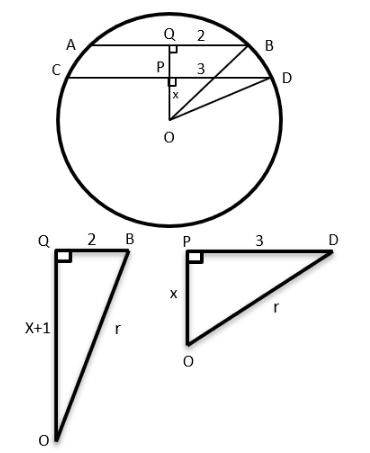
Given that Chords lie on the same side of diameter with lengths 4 cms and 6 cms
Draw a perpendicular from the origin to both the chords and mark the points of intersection as P
and Q respectively
Consider radius of circle as ‘r’ and distance OP as ‘x’
Draw lines from origin to the end of the chord and mark the points as D and B respectively
Thus, △OQB and △OPD form a right Triangle
Applying Pythagoras Theorem on both triangles,
(x+1) 2 +2 2 = r 2 ---(1)
x 2 +3 2 = r 2 ---(2)
We find that there is an increase and decrease by 1 in both equations
So, x 2 = 2 2 , x=2
r 2 = 2 2 +3 2 = 4+9 = 13
r = √13 cms
In a parallelogram ABCD of area 72 sq cm, the sides CD and AD have lengths 9 cm and 16 cm, respectively. Let P be a point on CD such that AP is perpendicular to CD. Then the area, in sq cm, of triangle APD is
Video Explanation

Explanatory Answer

Given Area (ABCD) = 72 sq cm, CD = 9cms, AD = 16cms
Area of Parallelogram = Base × Height
CD × 16 = 72
CD = 72167216 cms
We extend CD till P such that ∠APD = 90°
So, again by applying the area formula considering CD as base
CD × AP = Area of Parallelogram ABCD
9 × AP = 72
AP = 8 cms
We have AP = 8 cms, AD = 16 cms We observe that the ratio of the sides form a 1 : √3 : 2 triangle Therefore DP = 8√3 cms Area (△APD) = 1/2 × AD × DP = 1/2 × 8 × 8√3 sq cms Area (△APD) = 32 √3 sq cms
Humans and robots can both perform a job but at different efficiencies. Fifteen humans and five robots working together take thirty days to finish the job, whereas five humans and fifteen robots working together take sixty days to finish it. How many days will fifteen humans working together (without any robot) take to finish it?
Video Explanation

Explanatory Answer
Let a Human complete ‘H’ units of work per day and a Robot complete ‘R’ units of work per day
Given,
15H + 5R = (1/30) th work per day --- (1)
5H + 15R = (1/60) th work per day --- (2)
Dividing (1) and (2) by 5 and solving,
3H + R = (1/150) and H + 3R = (1/300)
9H + 3R = 1/50
(-) H + 3R = 1/300
---------------------------
8H = 1/50 - 1/300 => 8H = 1/60
H = 1/480
Work done by 15 Humans in a day = 15/480 = 1/32
No of days required for 15 humans to complete the work = 32 days
If log2(5 + log3a) = 3 and log5(4a + 12 + log2b) = 3, then a + b is equal to
Video Explanation

Explanatory Answer
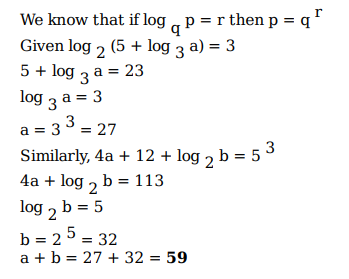
Raju and Lalitha originally had marbles in the ratio 4 : 9. Then Lalitha gave some of her marbles to Raju. As a result, the ratio of the number of marbles with Raju to that with Lalitha became 5 : 6. What fraction of her original number of marbles was given by Lalitha to Raju?
Video Explanation

Explanatory Answer
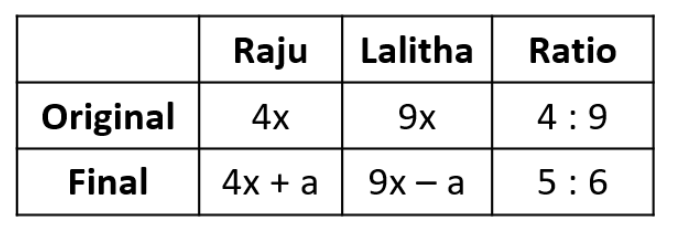
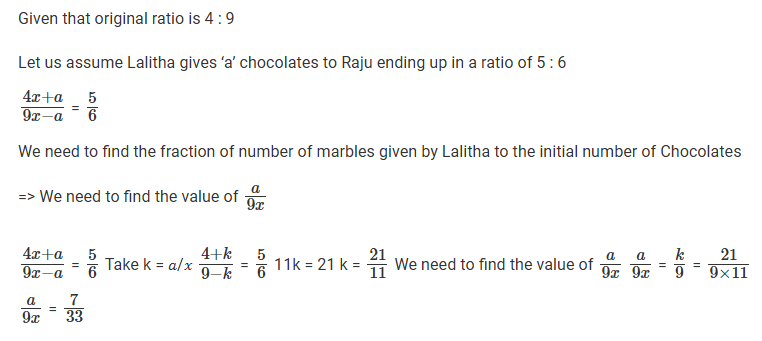
Given that x2018 y2017 = 1/2 and x2016 y2019 = 8, the value of x2 + y3 is
Video Explanation

Explanatory Answer
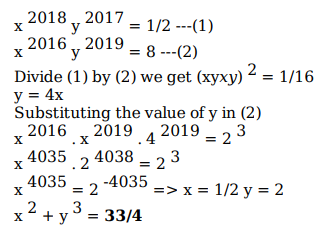
Points E, F, G, H lie on the sides AB, BC, CD, and DA, respectively, of a square ABCD. If EFGH is also a square whose area is 62.5% of that of ABCD and CG is longer than EB, then the ratio of length of EB to that of CG is:
Video Explanation

Explanatory Answer
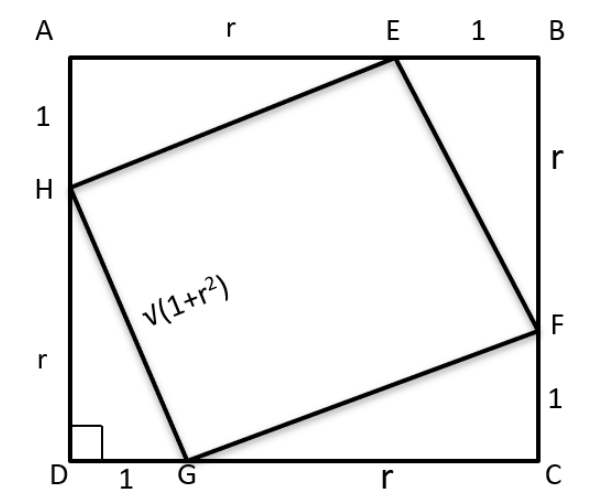

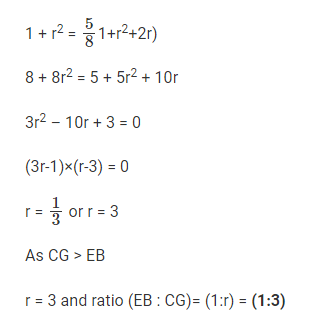
Train T leaves station X for station Y at 3 pm. Train S, traveling at three quarters of the speed of T, leaves Y for X at 4 pm. The two trains pass each other at a station Z, where the distance between X and Z is three-fifths of that between X and Y. How many hours does train T take for its journey from X to Y?
Video Explanation

Explanatory Answer

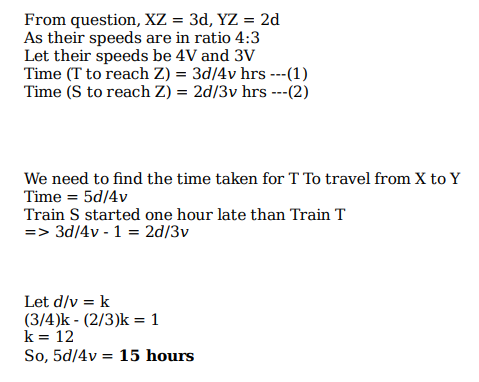
Each of 74 students in a class studies at least one of the three subjects H, E and P. Ten students study all three subjects, while twenty study H and E, but not P. Every student who studies P also studies H or E or both. If the number of students studying H equals that studying E, then the number of students studying H is
Video Explanation

Explanatory Answer

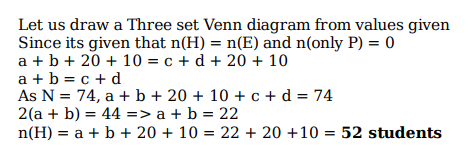
The number of integers x such that 0.25 < 2x < 200, and 2x + 2 is perfectly divisible by either 3 or 4, is
Video Explanation

Explanatory Answer
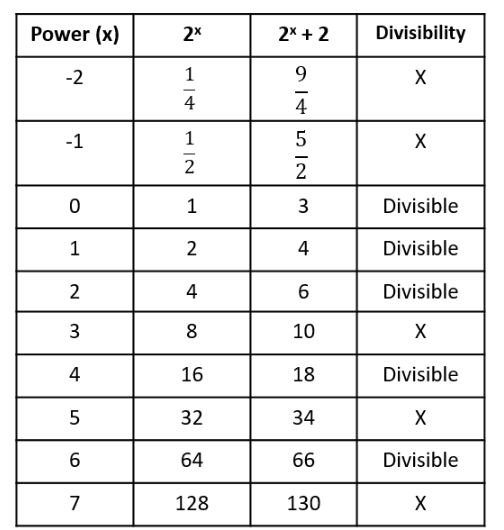

Let x, y, z be three positive real numbers in a geometric progression such that x < y < z. If 5x, 16y, and 12z are in an arithmetic progression then the common ratio of the geometric progression is
Video Explanation

Explanatory Answer


In an examination, the maximum possible score is N while the pass mark is 45% of N. A candidate obtains 36 marks, but falls short of the pass mark by 68%. Which one of the following is then correct?
Video Explanation

Explanatory Answer
Given Max. mark = N and Pass mark = 45% of N
A scores 36 marks and falls short of the pass mark by 68%
This means the pass mark must be reduced by (100 - 68)% = 32%
So, A scored 32% (45% N) = 36
N = 250 marks
The only option whose range falls within the obtained value is (B) 243 ≤ N ≤ 252
Let ABCD be a rectangle inscribed in a circle of radius 13 cm. Which one of the following pairs can represent, in cm, the possible length and breadth of ABCD?
Video Explanation

Explanatory Answer
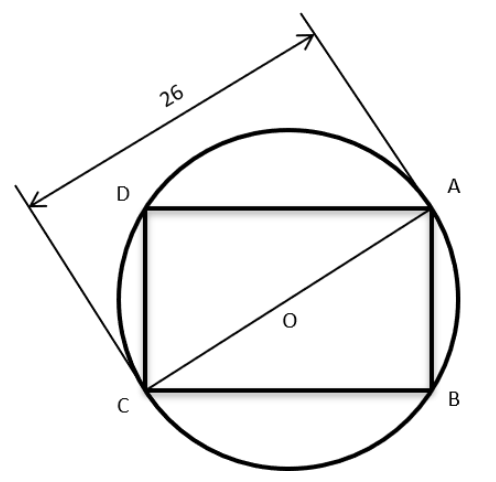
Since, ABCD is a rectangle inscribed inside a circle
ABC must be a Right triangle
Given that radius of Circle = 13 cms
5, 12, 13 forms a Pythagorean Triplet
10, 24, 26 is also a Pythagorean triplet
So, 10 and 24 are possible length and breadth of ABCD
Point P lies between points A and B such that the length of BP is thrice that of AP. Car 1 starts from A and moves towards B. Simultaneously, car 2 starts from B and moves towards A. Car 2 reaches P one hour after car 1 reaches P. If the speed of car 2 is half that of car 1, then the time, in minutes, taken by car 1 in reaching P from A is:
Video Explanation

Explanatory Answer

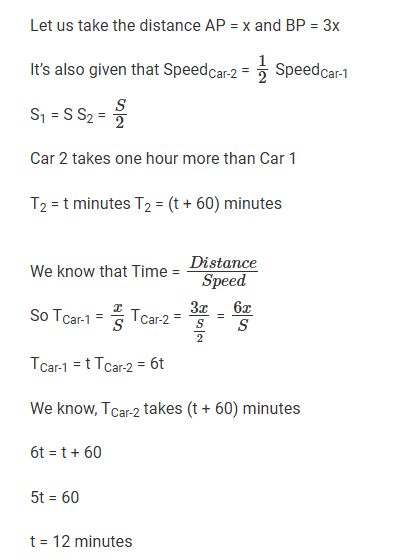
If u2 + (u−2v−1)2 = −4v(u + v), then what is the value of u + 3v?
Video Explanation

Explanatory Answer
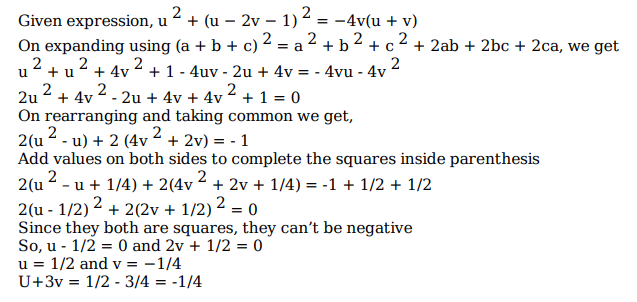
John borrowed Rs. 2,10,000 from a bank at an interest rate of 10% per annum, compounded annually. The loan was repaid in two equal instalments, the first after one year and the second after another year. The first instalment was interest of one year plus part of the principal amount, while the second was the rest of the principal amount plus due interest thereon. Then each instalment, in Rs., is:
Video Explanation

Explanatory Answer
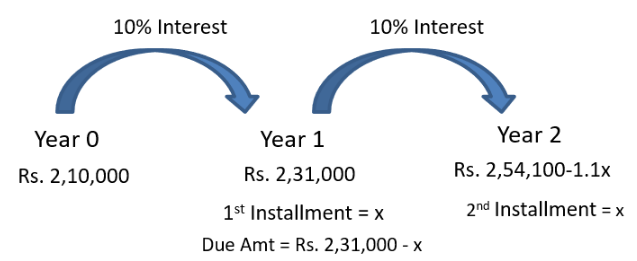
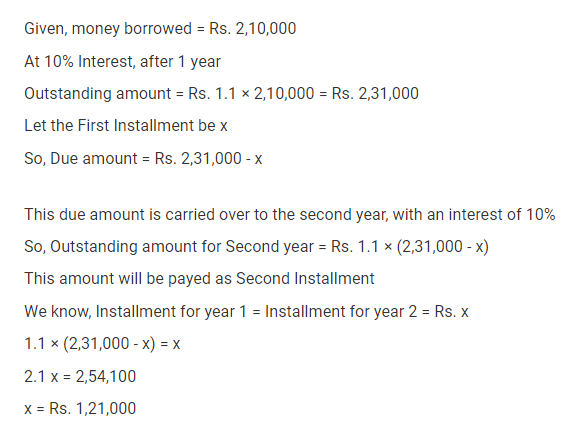
How many numbers with two or more digits can be formed with the digits 1, 2, 3, 4, 5, 6, 7, 8, and 9 so that in every such number, each digit is used at most once and the digits appear in the ascending order?
Video Explanation

Explanatory Answer

A right circular cone, of height 12 ft, stands on its base which has diameter 8 ft. The tip of the cone is cut off with a plane which is parallel to the base and 9 ft from the base. With π = 22/7, the volume, in cubic ft, of the remaining part of the cone is:
Video Explanation

Explanatory Answer
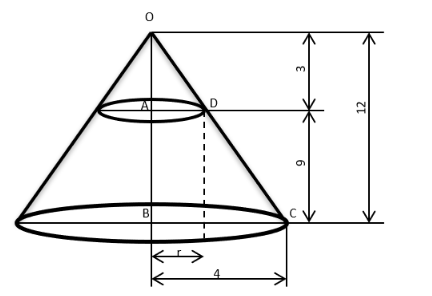
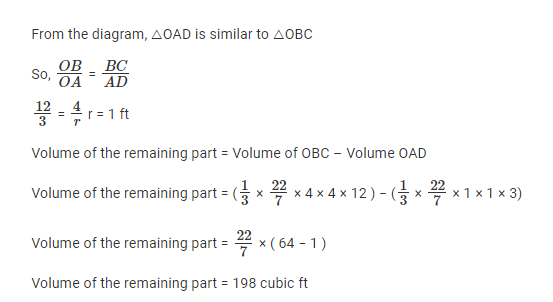
If x is a positive quantity such that 2x = 3log52 , then x is equal to
Video Explanation

Explanatory Answer
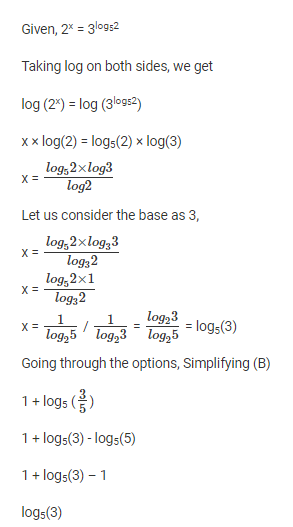
While multiplying three real numbers, Ashok took one of the numbers as 73 instead of 37. As a result, the product went up by 720. Then the minimum possible value of the sum of squares of the other two numbers is:
Video Explanation

Explanatory Answer
Let the three real numbers be a, b, c. c is taken as 73 instead of 37
So, 73ab = 37ab + 720
36 ab = 720
ab = 720/36 = 20
We know, AM ≥ GM
(a²+b²) / 2 ≥ ab
(a 2 + b 2 ) ≥ 2ab
(a 2 + b 2 ) ≥ 40
(Or)
ab = 20
(a,b) = (√20, √20)
(a 2 + b 2 ) = 20 + 20 = 40
Given an equilateral triangle T1 with side 24 cm, a second triangle T2 is formed by joining the midpoints of the sides of T1. Then a third triangle T3 is formed by joining the midpoints of the sides of T2. If this process of forming triangles is continued, the sum of the areas, in sq cm, of infinitely many such triangles T1, T2, T3,. will be
Video Explanation

Explanatory Answer
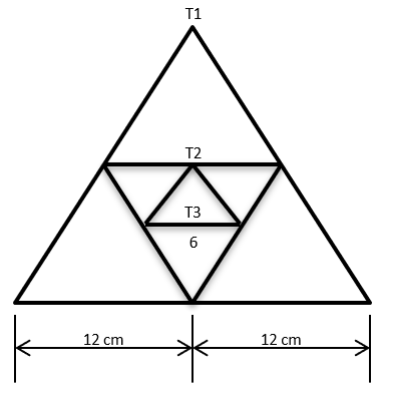
As the triangle progresses infinitely and the side length decreases, it follows an infinite GP series
As the sides decrease by half, their areas decrease by 1/4
We know, Area of an Equilateral Triangle = √3/4 × a 2
Area of T1 = √3/4 × 24 × 24 = 144 √3 sq cms
Sum of an Infinite GP = a / 1−r where a = 144 √3 , r = 1/4
Sum of areas ( T1, T2, T3,) = 144√3 / {1−(1/4)} = 4×144√3 / 3
Therefore, Sum of areas= 192 √3 sq cms.
When they work alone, B needs 25% more time to finish a job than A does. They two finish the job in 13 days in the following manner: A works alone till half the job is done, then A and B work together for four days, and finally B works alone to complete the remaining 5% of the job. In how many days can B alone finish the entire job?
Video Explanation

Explanatory Answer
Its given that B needs 25% more time than A
So, if Time taken by A = 4x days, Time taken by B = 5x days
A does half the work, So A works alone for 2x days --- (1)
A and B work for 4 days --- (2)
B works alone for 5x/20= x/4 days --- (3)
Total working days = 13
(1) + (2) + (3) = 13
2x + 4 + x/4 = 13 we get, x = 4
So, B alone can do the work in 5 × 4 = 20 days
Hence, the answer is 20 days
A wholesaler bought walnuts and peanuts, the price of walnut per kg being thrice that of peanut per kg. He then sold 8 kg of peanuts at a profit of 10% and 16 kg of walnuts at a profit of 20% to a shopkeeper. However, the shopkeeper lost 5 kg of walnuts and 3 kg of peanuts in transit. He then mixed the remaining nuts and sold the mixture at Rs. 166 per kg, thus making an overall profit of 25%. At what price, in Rs. per kg, did the wholesaler buy the walnuts?
Video Explanation

Explanatory Answer
Let the wholesaler bought walnuts and peanuts at Rs 3x and Rs x respectively
He sold 8kgs of Peanuts to the shopkeeper at 10% Profit
Cost price of the Peanuts bought by the shopkeeper = Rs. 1.1x per kg
Similarly, he sold 16 kgs of Walnuts to the shopkeeper at 20% Profit
Cost price of the Walnuts bought by the shopkeeper = 1.2 × 3x = Rs. 3.6x per Kg
He lost 5 kgs of Walnuts and 3 Kgs of Peanuts in transit
Remaining = 16 - 5 = 11 kgs of Walnuts & 8-3 = 5 kgs of Peanuts
He mixes them together and sells them at Rs. 166 per kg, making an overall Profit of 25%
Selling Price = 5/4 × Cost Price
Overall Cost Price = Rs.(3.6 × 16x + 1.1 × 8x)
Overall Selling Price = Rs. 16 × 166
Overall Selling Price = 5/4 × Overall Cost Price
(3.6 × 16x + 1.1 × 8x) × 5/4 = 16 × 166
( ( 57.6 × 8.8) x ) × 5/4 = 16 × 166
x = Rs. 32
Cost price per Kg of Walnuts bought by the Wholesaler = Rs. 3x = 3 × 32 = >Rs. 96









